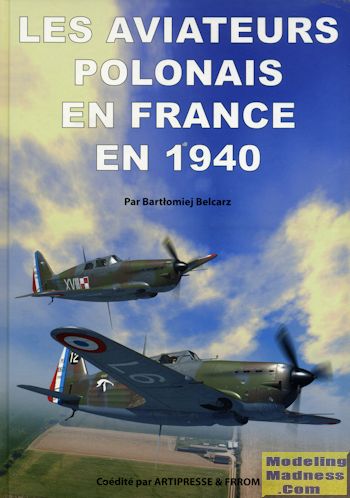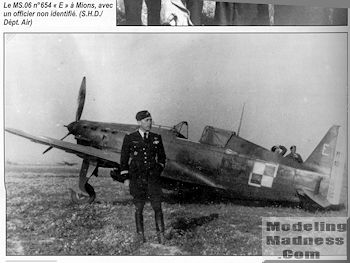 There
are times when an author decides to write a book that is so complete that it
will probably never be repeated. Such is the case with this one.
There
are times when an author decides to write a book that is so complete that it
will probably never be repeated. Such is the case with this one. FRROM/Artipress Les Aviateurs Polonais en France en 1940
| AUTHOR: | Bartlomij Belcarz |
|
PRICE: |
65 Euros plus shipping |
|
REVIEW : |
|
|
NOTES: |
420 pages, hardcover, hundreds of photos, color profiles.
ISBN 978-2-919231-03-4 |
 There
are times when an author decides to write a book that is so complete that it
will probably never be repeated. Such is the case with this one.
There
are times when an author decides to write a book that is so complete that it
will probably never be repeated. Such is the case with this one.
After the fall of Poland in September 1939, Polish soldiers, sailors, and airmen left the country in huge numbers so they could continue the fight against Germany. These men used many different venues to leave the country, most of them going through Romania, who made little effort to stem the tide. Eventually, these men ended up in various Allied countries, with a large number going to France. It was obvious that the French were going to have to deal with the nation on its eastern borders and the opportunity to fight was probably the best there as the French were in need of qualified soldiers. In this case, we are talking about airmen.
The Polish military in exile concentrated on France and Polish pilots began either training on French aircraft or directly entering various squadrons. This was a rather strained political situation for the Allied nations. The Poles wanted to have nearly all Polish units, lead by Poles, while the Allied nations (and this was mostly Britain and France) did not want an autonomous armed force operating within its borders. The French acquiesced to an extent and some squadrons were completely Polish right down to the planes wearing the Polish insignia. The British, however, were more recalcitrant and while they allowed Polish airmen into the RAF and eventually allowed the formation of Polish squadrons, these were led by British officers and the planes did not carry Polish cocades. Of course, by the time of 1942, things had changed and the Brits did allow autonomous USAAF and US Army units to operate from the UK.
Typical of France during 1939 and 1940, things did not go quickly. There
were difficulties in getting things up and running and politics played its part
in helping to delay decisions. Eventually, hundreds of Polish airmen were able
to get into the
 air
against the Germans and several all-Polish squadrons were formed, though in the
latter case it was only at the very end of hostilities in France that this
happened. Most pilots were in fighter squadrons, though there were some in
bomber and observation units as well.
air
against the Germans and several all-Polish squadrons were formed, though in the
latter case it was only at the very end of hostilities in France that this
happened. Most pilots were in fighter squadrons, though there were some in
bomber and observation units as well.
Once France fell, it was time to beat feet once more and most of these men were able to escape via French ports on the south and west, eventually making their way to either North Africa or England. Those in North Africa eventually left and joined their comrades in the UK where they helped make up the largest contingent of non-Commonwealth squadrons, fighting until the end of the war.
This book by Bartlomiej Belcarz has been over 14 years in the making and contains hundreds of period photos of men, planes and locations, many of the images coming from private hands and being shown here for the first time. A great deal of primary research has been done to make this most complete. It covers the various journeys out of Poland and later out of France. Every Polish pilot and the squadron in the French Air Force in which they served in covered.
The major portion of the book covers the units in which these men served and is divided by unit type and the aircraft they flew. Throughout the book are tables of aircraft flown, air victories, and losses. At the end of the book are several pages of full color profiles covering many of the aircraft we have seen earlier in photographs. As you might guess from the title, this book is published in French, but thankfully, this does not detract from the usefulness of what really is a tome on the subject. Though my French is poor to say the least, I was able to piece together what was going on. The photos, tables and profiles alone make this an excellent book and an outstanding reference on the subject. If you are fluent in French, so much the better. A book that will probably never be bested and one that I have no trouble recommending to the enthusiast.
July 2015
Thanks to Gilles Fontaine of Azur/FRROM for the review copy. You can get this from www.artipresse.com or in France, from your local bookseller.
If you would like your product reviewed fairly and fairly quickly, please contact the editor or see other details in the Note to Contributors.